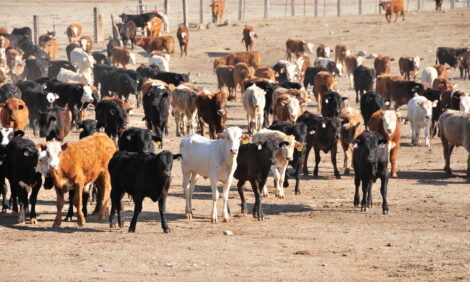



Weekly Roberts Market Report
US - China has suspended imports of soybean oilmeal from India after finding contamination in rapeseed last year, writes Michael T. Roberts.Michael T. Roberts
Extension Agriculture Economist,
Dairy and Commodity Marketing,
NC State University
DAIRY CLASS III futures on the Chicago Mercantile Exchange (CME) closed down on Monday. The JAN’12DA contract closed at $17.09/cwt; off $0.01/cwt. MAR’12DA futures closed at $16.54/cwt; down $0.15/cwt. The JULY’12DA contract closed up $0.09/cwt at $17.15/cwt. Increased milk productions and higher grain prices weighed on prices. December milk production was up 2.5% over last year with an estimated 16.559 bi lbs for last month. Cow numbers were up 12,000 head from November. Production per cow was 57.9 lbs/day, up 0.9 lbs (1.6%). Fonterra reported record-high exports of 246,000 tons in December; 17% over this time last year. Southeast Asia, China, the Middle East, and North Africa are driving export growth. CWT accepted bids to help with up to 4.0 mi lbs of cheese for delivery through June. CWT assisted exports averaged 3.3 mi lb/mo since May 2010. Milk margin for dairy producers declined from November 2011 through December 2011 but still finished 15% over 2010.
Current average futures prices for Class III milk declined a range of $0.80 - $0.60/cwt. Prices were: 3 months out = $16.64/cwt; 6 months out = $16.70/cwt; 9 months out = $16.86/cwt; and 12 months out = $16.92/cwt.
LIVE CATTLE futures on the Chicago Mercantile Exchange (CME) closed up on Monday. The APR’12 contract finished up $0.45/cwt at $128.175/cwt. JUNE’12LC futures closed at $127.000/cwt; up $0.675/cwt. DEC’12LC futures closed at $131.300/cwt; up $0.375/cwt. Bullish demand factors and outside markets were supportive. Repositioning in cattle futures, a weaker U.S. dollar, and strong demand on tightening supplies were supportive. Higher feed prices weighed on prices. Last week’s USDA report confirmed tightening supplies. The mix of signals will slow trader momentum while waiting for clearer signs. Slaughter was down 9,000 head on higher cash prices. USDA on Monday put the 5-area average at $125.73/cwt. See graph.
FEEDER CATTLE at the CME finished up on Monday with the exception of the March ’12 contract. The JAN’12FC contract settled at $151.900/cwt; up $0.275/cwt. APR’12FC futures finished at $155.400/cwt; up $0.200/cwt. The AUG’12FC contract closed up $0.325/cwt at $157.675/cwt. Feeders were supported by higher commodity prices and tight supplies. The Oklahoma National Stockyard feeder cattle auction estimated receipts for Monday, 1/23/12 at 9,500 head compared to 11,265 last week and 9,829 a year ago. Compared to last week feeder steers and heifers were $2-$4 higher. Steer calves were $4/cwt lower while heifer calves were $1-$4/cwt higher. Demand was good for feeder cattle and extremely good for cattle bought by folks putting them on pasture. Quality for calves was plain to average. Numbers of cattle less than 500 lbs are declining but this is average for this time of year. Late Monday the CME feeder cattle index for 1/20/12 was placed at $151.35; off $0.04 from the previous close.
CORN futures on the Chicago Board of Trade (CBOT) closed up on Monday. MAR’12 futures closed at $6.200/bu; up 8.5¢/bu. The DEC’12 contract closed up 4.5¢/bu at $5.562/bu. Slower-than-expected moisture counts in South America, higher cash markets, and a weaker U.S. dollar were supportive. The larger-than-expected supply forecast last week cast a bearish tone over the market. However, most marketers and traders don’t really expect the report to hold up. Exports were neutral with USDA putting corn-inspected-for-export at 35.198 mi bu vs. estimates of 32-38 mi bu. Exports were up 5 mi bu over last week. Slow farmer sales have cash markets soaring. Farmers are holding back waiting on a return to higher prices. According to several floor sources in Chicago and a dozen merchandisers across the Corn Belt the cash market is very hot right now. Exporters are snapping up supplies to meet international demand. It might be a good idea to buy some near-to-medium term supplies before the end of the week.
SOYBEAN futures on the Chicago Board of Trade (CBOT) closed up on Monday. The MAR’12 contract closed at $12.174/bu; up 30.5¢/bu. NOV’12 futures closed at $12.074/bu; up 23.75¢/bu. Worries over harsh weather in Argentina, brisk cash sales, and weak dollar were supportive. Exports were neutral at 35.666 mi bu vs. estimates for 33-39 mi bu. Disappointing rainfall in Argentina leaving over one-third of the corn and soybean producing area is hurting South American supply. Argentina is the world’s third largest exporter of soybeans and the largest exporter of soymeal and soyoil.
Another international demand element factoring into higher prices is that China has suspended imports of soybean oilmeal from India after finding contamination in rapeseed last year. The dollar fell against a number of currencies, with the euro hitting a near three-week high. Several floor sources said the weaker dollar was really driving prices. A weaker dollar makes commodities priced in U.S. currency more attractive to exporters.
WHEAT futures in Chicago (CBOT) closed up on Monday. The MAR’12 contract closed at $6.196/bu; up 9.25¢/bu. JULY’12 wheat futures finished at $6.542/bu; up 10.5¢/bu. Positive momentum from last week and a weaker U.S. dollar making wheat more competitive in global markets was supportive. However, global wheat stocks are the highest in more than a decade weighing on prices. Exports were neutral with USDA putting wheat-inspected-for-export at 17.106 mi bu vs. estimates for 15-20 mi bu. Chart signals continue to indicate speculators may be interested in buying wheat futures soon. All it will take is a global trigger to indicate supply will be removed more quickly than is thought now.


